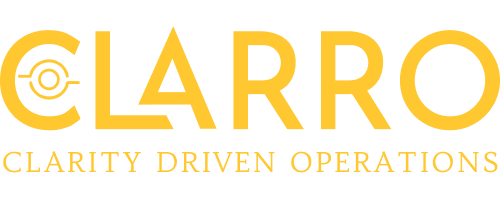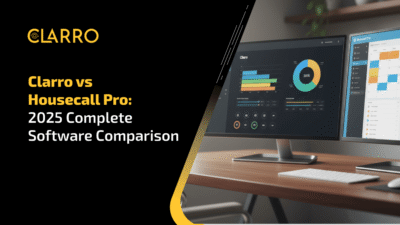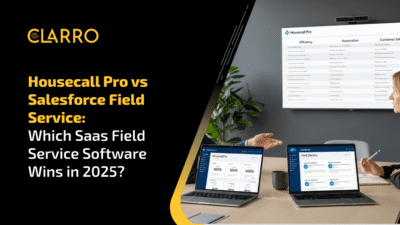Starting a small business is tough. You wear multiple hats, juggle tight budgets, and somehow need to compete with companies that have entire teams dedicated to tasks you handle alone.
Here’s the good news: small business software has leveled the playing field. The best SaaS tools for startups now give you capabilities that once required massive investments. You can automate repetitive tasks, manage customer relationships, handle accounting, and run marketing campaigns—all without hiring specialists or breaking the bank.
But with thousands of options available, which tools actually deserve your limited budget and attention? Let’s cut through the noise and look at the small business automation software that delivers real results.
Why Small Businesses Need SaaS Tools
Before jumping into specific tools, let’s talk about why SaaS matters for your business.
Traditional software meant huge upfront costs, complicated installations, and IT teams to maintain everything. SaaS changed all that. You pay monthly, access everything through your browser, and updates happen automatically. For small businesses, this model is perfect.
According to BetterCloud’s 2024 State of SaaS report, small businesses now use an average of 110 different SaaS applications. That might sound overwhelming, but here’s what matters: companies using the right SaaS tools grow 3x faster than those relying on manual processes.
The ROI is clear. Businesses report saving 20-30 hours per week on average after implementing small business automation software, according to Zapier’s 2024 Automation Report. That’s almost an entire work week back in your hands.
Communication & Collaboration Tools
Team Communication Platforms
If your team is still using email for internal communication, you’re wasting time. Modern team messaging platforms organize conversations into channels, making it easy to find information and keep everyone on the same page.
Key Features to Look For:
- Channel-based messaging for organized conversations
- Direct messaging for quick one-on-one chats
- File sharing and searchable history
- Integration capabilities with other business tools
Why Small Businesses Need It: Team communication tools reduce email by 32% and meetings by 27%, according to industry studies. Your team spends less time searching for information and more time getting work done.
Video Conferencing Solutions
Video calls became essential over the past few years. The right video conferencing tool is simple enough that anyone can use it, yet powerful enough for presentations and large team meetings.
Key Features to Look For:
- HD video and audio quality
- Screen sharing capabilities
- Recording and transcription
- Virtual meeting rooms
Why It Matters: 92% of remote workers say video conferencing helps them feel more connected to their teams (Owl Labs, 2024).
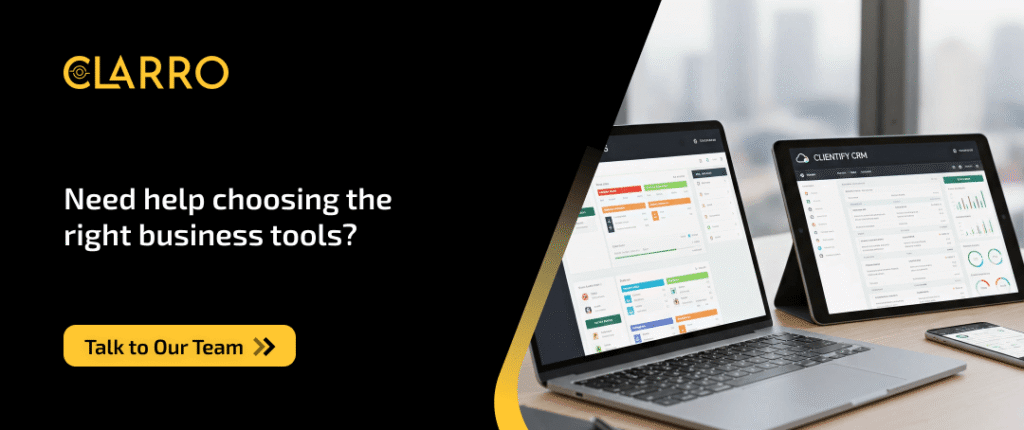
Project Management & Productivity
Task Management Systems
Managing projects through email threads and spreadsheets is chaos. Modern task management systems bring order to your workflows, helping teams track who’s doing what by when.
Key Features:
- Task assignments with due dates
- Project timelines and calendars
- Custom workflows for different processes
- Progress tracking and reporting
Real Impact: Teams using proper task management report 45% fewer emails and 50% faster project completion, based on industry data.
Visual Project Boards
If your brain thinks in pictures, visual project boards are ideal. They use card-based systems that make it easy to see what needs doing, what’s in progress, and what’s complete.
Key Features:
- Kanban-style boards for visual workflow
- Drag-and-drop task management
- Checklists and due dates
- Customizable workflows
Best For: Creative teams, content production, and anyone who prefers visual organization over lists.
Customer Relationship Management (CRM)
Why CRM Software Matters
You can’t grow without understanding your customers. A good CRM tracks every interaction, helping you build better relationships and close more deals.
Essential CRM Features:
- Contact and company records
- Email tracking and templates
- Deal pipeline management
- Meeting scheduling and automation
- Mobile access for on-the-go updates
The Numbers: Companies using CRM software see an average 29% increase in sales, according to Salesforce research. Businesses with proper CRM systems close 36% more deals on average.
Choosing the Right CRM
For Startups: Look for free or low-cost options with basic contact management and deal tracking. You can upgrade as you grow.
For Growing Businesses: Invest in CRM with automation, advanced reporting, and integration capabilities.
For Established Small Businesses: Consider enterprise-level features like sales forecasting, territory management, and custom workflows.
Accounting & Finance Tools
Cloud Accounting Software
Tax season doesn’t have to be stressful. Modern cloud accounting handles your bookkeeping automatically, tracking income, expenses, and generating reports your accountant will love.
Key Features:
- Automatic transaction categorization
- Invoice creation and tracking
- Expense tracking via mobile app
- Tax preparation and filing support
- Financial reporting and insights
Small Business Impact: Users save an average of 20 hours per month on bookkeeping tasks with proper accounting software.
Payment Processing Solutions
Whether you’re selling online, in-app, or in-person, reliable payment processing is essential for small business operations.
Key Features:
- Credit card and digital wallet processing
- Subscription billing capabilities
- Fraud prevention tools
- Detailed financial reporting
- Multiple currency support
Trust Factor: Modern payment processors handle billions in transactions with 99.99% uptime, ensuring your business never loses a sale.
Marketing & Customer Engagement
Email Marketing Platforms
Email isn’t dead—it’s one of your best marketing channels. The right email marketing platform makes it easy to build email lists, create campaigns, and track results.
Key Features:
- Email campaign builder with templates
- Audience segmentation
- Automation workflows
- Analytics and A/B testing
- Contact management
ROI Reality: Email marketing returns $36 for every $1 spent, according to Litmus’s 2024 State of Email report. Businesses using email automation see average open rates of 21.5%.
Design Tools for Marketing
You don’t need a graphic design degree to create eye-catching visuals. Modern design platforms provide templates and tools that make anyone look like a pro.
Key Features:
- Templates for social media, presentations, and marketing materials
- Drag-and-drop design interface
- Stock photos and graphics library
- Brand kit for consistent visuals
- Collaboration features for teams
Usage Stats: Small businesses using design tools create an average of 1.5 marketing visuals per day, significantly increasing their content output.
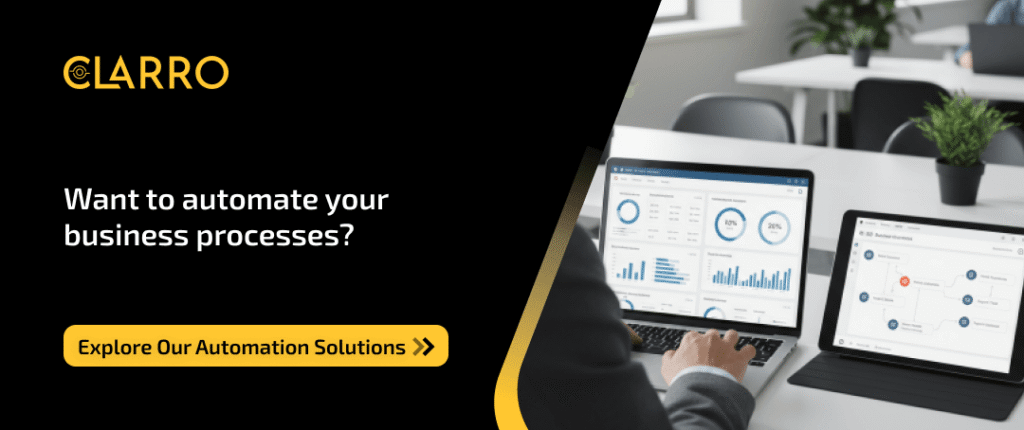
File Storage & Document Management
Cloud Storage Solutions
Modern businesses need secure, accessible file storage that works across devices and enables team collaboration.
Key Features:
- Generous cloud storage space
- Real-time document collaboration
- Automatic syncing across devices
- Version history and file recovery
- Sharing controls and permissions
Collaboration Boost: Teams using cloud storage report 20% faster document completion due to real-time collaboration features.
Document Management Systems
When you need to organize large volumes of documents, specialized document management systems provide structure and searchability.
Key Features:
- Secure file storage and organization
- Advanced search capabilities
- Version control
- Integration with productivity tools
- Compliance and security features
Security Note: Enterprise-grade encryption ensures your business documents stay protected.
E-commerce & Online Selling
E-commerce Platforms
Want to sell products online? Modern e-commerce platforms get you up and running quickly with everything you need.
Key Features:
- Customizable online store templates
- Inventory management
- Payment processing integration
- Shipping and fulfillment tools
- Product catalog management
- Customer management
Success Rates: Small businesses using dedicated e-commerce platforms average $63,000 in yearly online revenue.
Point of Sale (POS) Systems
If you sell in-person, integrated POS systems connect your physical and online sales, inventory, and customer data.
Key Features:
- Payment processing (cards, mobile, contactless)
- Inventory tracking across locations
- Customer relationship management
- Sales reporting and analytics
- Employee management
Business Impact: Integrated POS systems reduce inventory discrepancies by 35% and improve checkout speed by 40%.
Social Media Management
Social Scheduling Tools
Managing multiple social media accounts eats up time. Social media management tools let you schedule posts in advance and track performance from one dashboard.
Key Features:
- Multi-platform scheduling (Facebook, Instagram, Twitter, LinkedIn)
- Analytics and reporting
- Team collaboration features
- Content calendar
- Post preview and optimization
Time Savings: Users report spending 50% less time on social media management after adopting scheduling tools.
Social Analytics Platforms
Understanding what works on social media requires proper analytics. Advanced platforms provide insights that help you improve engagement and reach.
Key Features:
- Performance metrics across platforms
- Audience insights and demographics
- Competitive analysis
- Content recommendations
- Custom reporting
Performance Data: Businesses using analytics-driven social strategies see 58% higher engagement rates compared to manual posting.
All-in-One Business Management Solutions
Sometimes you don’t want to juggle multiple tools. All-in-One Business Management & Automation Tools combine several functions into single platforms, reducing complexity and cost.
Benefits of Integrated Platforms
Reduced Complexity: One login, one interface, one system to learn.
Better Data Flow: Information automatically syncs between modules—no manual data entry.
Cost Savings: Bundled pricing is typically cheaper than buying separate tools.
Unified Reporting: See your entire business performance in one dashboard.
What to Look for in All-in-One Solutions
Core Features:
- Project and task management
- Customer relationship management
- Financial tracking and invoicing
- Team collaboration tools
- Document storage and sharing
- Time tracking and resource management
Advanced Features:
- Workflow automation
- Custom fields and forms
- API access for integrations
- Mobile apps for field work
- Advanced reporting and analytics
Scalability: The best platforms grow with you, offering more features as your business expands.
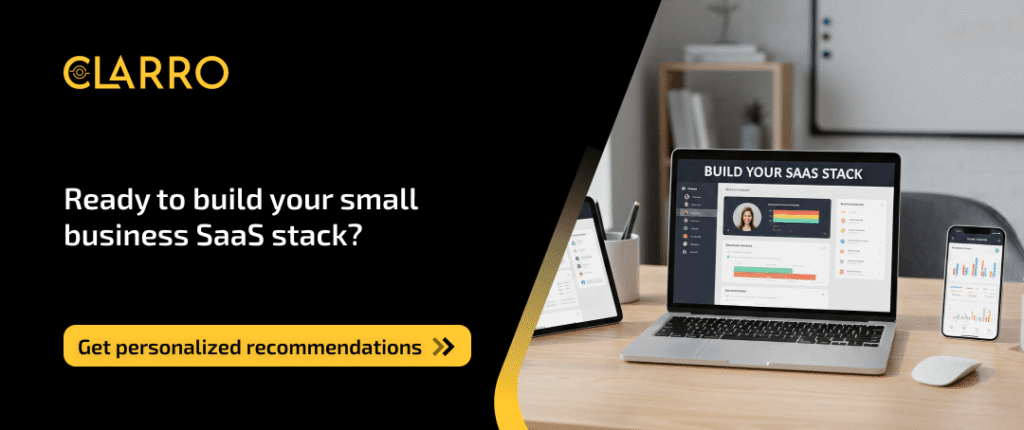
Comparison: Which Tools Should You Start With?
Choosing the right small business automation software depends on your specific needs and budget. Here’s a practical comparison guide:
| Business Need | Priority Level | When to Implement | Average ROI Timeline |
| Team Communication | High | Immediately | 1 month |
| Project Management | High | Within the first 3 months | 2-3 months |
| CRM | Critical | Before hiring the sales team | 3-4 months |
| Accounting | Critical | Day one | Immediate |
| Email Marketing | Medium | After 100 contacts | 4-6 months |
| File Storage | High | Within first month | 1-2 months |
| Design Tools | Medium | When creating content regularly | 2-3 months |
| E-commerce | Critical (for retailers) | Before first sale | 3-6 months |
The Real Cost of SaaS Tools
Let’s talk numbers. Understanding the true cost of small business software helps you budget effectively.
Typical Small Business SaaS Budget
For a team of 5 people, a comprehensive stack might include:
- Communication: $35-50/month
- Project Management: $50-75/month
- CRM: $50-100/month
- Accounting: $50-100/month
- Email Marketing: $30-75/month
- Cloud Storage: $30-60/month
Total Monthly Investment: $245-460/month
That might seem like a lot, but consider the alternative: hiring additional staff to handle these tasks manually would cost thousands monthly.
ROI of Small Business Software
According to a 2024 study by Software Advice, small businesses using comprehensive SaaS tools report:
- 40% reduction in operational costs
- 35% increase in productivity
- 28% faster revenue growth
The ROI typically pays for itself within 3-4 months.
Hidden Costs to Consider
Training Time: Budget 5-10 hours per tool for team training Integration Setup: Some connections require technical knowledge Data Migration: Moving from old systems takes time Subscription Management: Track renewals to avoid surprise charges
Integration: Making Your Tools Work Together
The best SaaS tools for startups don’t work in isolation—they connect with each other. This is where small business automation software really shines.
Why Integration Matters
Example Workflow:
- Customer fills out contact form on your website
- Automatically creates contact in your CRM
- Triggers welcome email series
- Notifies sales team via communication platform
- Creates follow-up task in project management system
This entire sequence happens automatically, saving hours of manual work weekly.
Common Integration Scenarios
Sales Process:
- Website form → CRM → Email marketing → Task creation
Customer Support:
- Support ticket → Team notification → Time tracking → Invoice creation
Content Creation:
- Content calendar → Task assignment → File sharing → Social scheduling
Financial Tracking:
- Sale completed → Payment processed → Invoice sent → Accounting updated
Automation Tools
Modern automation platforms connect hundreds of applications without coding. For example:
- Create automatic workflows between apps
- Sync data across multiple systems
- Trigger actions based on specific events
- Schedule regular data transfers
The Impact: Businesses using automation save an average of 10 hours per week on manual data entry and routine tasks.
Building Your Small Business SaaS Stack
Don’t try to implement everything at once. Here’s a practical rollout strategy:
Phase 1: Foundation (Month 1)
Start with the essentials:
- Accounting software
- Cloud storage solution
- Basic CRM system
Goal: Establish financial tracking and basic customer management
Phase 2: Growth Tools (Months 2-3)
Add tools that help you scale:
- Project management system
- Email marketing platform
- Team communication tool
Goal: Improve team coordination and customer engagement
Phase 3: Optimization (Months 4-6)
Implement advanced features:
- Marketing automation
- Advanced analytics
- Integration and automation tools
Goal: Reduce manual work and improve efficiency
Phase 4: Specialization (6+ months)
Add industry-specific tools based on your business type:
- E-commerce platforms (for retailers)
- Booking systems (for service businesses)
- Inventory management (for product businesses)
Goal: Address unique business needs with specialized solutions
This phased approach prevents overwhelm and gives your team time to adapt to new systems.
Common Mistakes to Avoid
After working with hundreds of small businesses implementing SaaS tools, we’ve seen these mistakes repeatedly:
1. Buying Too Much Too Soon
Don’t get every tool that sounds useful. Start small and add as you grow. Many businesses waste money on subscriptions they never use.
Solution: Start with 3-5 core tools and add more only when you feel limited by current capabilities.
2. Ignoring Training
Even the best small business software fails if your team doesn’t know how to use it. Budget time for training and onboarding.
Solution: Dedicate 1 hour per week for team training on new tools for the first month.
3. Not Checking Integrations
Before committing to a tool, verify it connects with your existing systems. Disconnected tools create more work, not less.
Solution: Test integrations during free trials before purchasing.
4. Forgetting About Mobile
Your team needs access on the go. Make sure critical tools have solid mobile apps.
Solution: Test mobile functionality before committing to any business-critical tool.
5. Skipping the Free Trials
Almost every SaaS tool offers a free trial. Use it. Test the software with your actual workflows before paying.
Solution: Create a trial testing checklist with real-world scenarios to evaluate.
6. Ignoring User Limits
Many tools charge per user. Understand how pricing scales as your team grows.
Solution: Project your team size 12 months ahead and calculate future costs.
7. Poor Password Management
With multiple tools comes multiple passwords. Weak security practices put your business at risk.
Solution: Use a business password manager to secure all your SaaS accounts.
Security and Data Protection
Small businesses are increasingly targeted by cybercriminals. When choosing SaaS tools, security matters:
What to Look For:
- SOC 2 Type II certification – Industry-standard security audit
- GDPR compliance – Even if you’re not in Europe, it shows commitment to privacy
- Two-factor authentication – Essential for protecting business accounts
- Regular security audits – Look for companies that prioritize security
- Data encryption – Both in transit and at rest
- Backup and recovery – Ensure your data can be restored if something goes wrong
Security Best Practices:
- Enable two-factor authentication on all business accounts
- Use strong, unique passwords for each service
- Regularly review user access and remove former employees
- Keep software updated to latest versions
- Train team on phishing and security threats
According to Verizon’s 2024 Data Breach Report, 43% of cyberattacks target small businesses. Using reputable SaaS tools with strong security is cheaper than recovering from a data breach.
Measuring Success: Key Metrics
How do you know if your small business automation software is working? Track these metrics:
Time Savings Metrics
- Hours spent on manual tasks (before vs. after)
- Time to complete common processes
- Reduction in administrative work
- Faster response times to customers
Cost Efficiency Metrics
- Total SaaS spend vs. productivity gains
- Reduction in operational overhead
- Decreased need for additional hires
- Savings from reduced errors and rework
Revenue Impact Metrics
- Sales growth after implementing CRM
- Conversion rate improvements from marketing tools
- Customer retention rates
- Average deal size changes
Team Satisfaction Metrics
- Employee feedback on tool effectiveness
- Reduction in frustration with manual processes
- Adoption rates across team
- Time saved on collaboration
Implementation Tip: Set baseline measurements before implementing new tools, then review progress quarterly.
The Future: What’s Next for Small Business Software
SaaS tools continue evolving rapidly. Here’s what’s coming:
AI Integration
Most tools now include AI features—chatbots, predictive analytics, automated content creation. By 2025, Gartner predicts 80% of SaaS applications will have embedded AI capabilities.
For Small Businesses: AI levels the playing field, giving you capabilities that once required large teams and budgets.
No-Code Platforms
Tools that let you build custom workflows without programming are exploding. This puts powerful customization in the hands of small businesses.
Impact: Create custom solutions without hiring developers.
Mobile-First Design
As remote work continues, SaaS providers are prioritizing mobile experiences over desktop.
Why It Matters: Run your business from anywhere, not just the office.
Vertical-Specific Solutions
Instead of general tools, we’re seeing more industry-specific software designed for restaurants, salons, law firms, construction, and other specialized businesses.
Advantage: Get features built specifically for your industry’s needs.
Deeper Integration
The future is about tools that talk to each other seamlessly, creating unified business operating systems.
Result: Less manual work, more automation, better insights.
Conclusion
The right small business software transforms how you work. It automates tedious tasks, helps you serve customers better, and gives you insights that drive smart decisions.
You don’t need every tool mentioned here. Start with the basics—accounting, CRM, and collaboration tools. Add marketing and project management as you grow. Focus on integration so your tools work together smoothly.
The best SaaS tools for startups aren’t necessarily the most expensive or feature-rich. They’re the ones that solve your specific problems, fit your budget, and your team actually uses.
Remember: technology is just a tool. It amplifies good processes but won’t fix broken ones. Before adding new software, clarify your workflows and goals. Then choose tools that support those objectives.
Your Action Plan:
This Week:
- Audit your current tools and processes
- Identify your biggest time wasters
- Research solutions for your top 3 pain points
This Month:
- Start free trials of 2-3 tools
- Test them with real work scenarios
- Get team feedback on usability
This Quarter:
- Implement 3-5 core tools
- Train your team thoroughly
- Set up basic integrations
- Measure time and cost savings
The small businesses winning today aren’t the ones with the most tools—they’re the ones with the right tools used effectively.
Ready to build your stack? Start with one or two tools this month. Learn them well. Then gradually add more as your needs grow. Your future self will thank you for taking this step toward automation and efficiency.
For more detailed guidance on building your technology foundation, explore our comprehensive resources on business automation and check out SaaS business solutions examples to see how other small businesses are using technology effectively.
Want to learn more about building your business technology foundation?
Check out our guide: Ultimate Canadian SaaS Tech Stack for Small Businesses
FAQs
1. What is the difference between SaaS tools and traditional software for small businesses?
SaaS (Software as a Service) tools are cloud-based and accessible through a web browser, meaning no installation or IT maintenance is required. Traditional software often requires upfront purchases, complex setups, and manual updates. SaaS allows for subscription-based pricing, automatic updates, and scalability as your business grows.
2. How can I choose the right SaaS tools without overspending?
Start by identifying your core business needs—like accounting, CRM, or project management. Use free trials to test usability and integration with your existing tools. Begin with 3–5 essential tools and expand only as your business grows. This prevents unnecessary subscriptions and ensures your team actually uses the software.
3. Can small businesses benefit from automation tools even if they have a tiny team?
Absolutely. Automation tools save time on repetitive tasks like email campaigns, invoicing, or customer follow-ups. Even a team of 2–3 people can reclaim several hours per week, reduce human errors, and scale operations without hiring extra staff.
4. Are SaaS tools secure enough for handling sensitive business data?
Yes, reputable SaaS providers implement enterprise-grade security, including encryption, two-factor authentication, regular audits, and compliance with standards like SOC 2 and GDPR. Small businesses should still enforce best practices, like strong passwords and restricted access, to maximize security.
